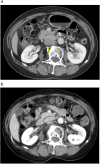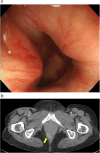Squamous cell carcinoma of the anus successfully treated with multidisciplinary therapy for metachronous metastatic and local recurrences after DCF chemotherapy: a case report
- PMID: 38526705
- PMCID: PMC10963677
- DOI: 10.1186/s40792-024-01873-2
Squamous cell carcinoma of the anus successfully treated with multidisciplinary therapy for metachronous metastatic and local recurrences after DCF chemotherapy: a case report
Abstract
Background: Docetaxel, cisplatin, and 5-fluorouracil (DCF) chemotherapy is reportedly an effective treatment strategy for squamous cell carcinoma of the anus (SCCA). However, studies regarding its use in Japanese patients remain scarce.
Case presentation: Here, we present the case of an 82-year-old woman with SCCA, cStage IIIB. Chemoradiotherapy was initiated after colostomy of the anorectal mass; however, para-aortic lymph node recurrence was observed 3 months after treatment completion. Five courses of DCF chemotherapy were subsequently administered, resulting in a complete response (CR). Two years and 1 month later, the aortic lymph node was enlarged again, and the patient achieved CR again after radiotherapy. Nine months later, local recurrence was detected in the anal canal, and laparoscopic perineal rectal amputation was performed. The patient remains progression-free 5 years and 10 months after the initial treatment and 1 year and 7 months after the final treatment.
Conclusions: Our findings suggest that complementary treatment after DCF chemotherapy may be efficacious in Japanese patients with SCCA and help achieve CR. Despite occasional local recurrences, this approach may help achieve long-term progression-free survival.
Keywords: 5-Fluorouracil; Cisplatin; Docetaxel; Squamous cell carcinoma of the anus.
© 2024. The Author(s).
Conflict of interest statement
The authors declare no competing interests.
Figures





Similar articles
-
DCF (docetaxel, cisplatin and 5-fluorouracil) chemotherapy is a promising treatment for recurrent advanced squamous cell anal carcinoma.Ann Oncol. 2013 Dec;24(12):3045-50. doi: 10.1093/annonc/mdt396. Epub 2013 Oct 10. Ann Oncol. 2013. PMID: 24114858
-
Docetaxel, Cisplatin, and 5-fluorouracil (DCF) chemotherapy in the treatment of metastatic or unresectable locally recurrent anal squamous cell carcinoma: a phase II study of French interdisciplinary GERCOR and FFCD groups (Epitopes-HPV02 study).BMC Cancer. 2017 Aug 25;17(1):574. doi: 10.1186/s12885-017-3566-0. BMC Cancer. 2017. PMID: 28841909 Free PMC article. Clinical Trial.
-
Docetaxel, cisplatin, and fluorouracil chemotherapy for metastatic or unresectable locally recurrent anal squamous cell carcinoma (Epitopes-HPV02): a multicentre, single-arm, phase 2 study.Lancet Oncol. 2018 Aug;19(8):1094-1106. doi: 10.1016/S1470-2045(18)30321-8. Epub 2018 Jul 2. Lancet Oncol. 2018. PMID: 30042063 Clinical Trial.
-
Docetaxel, Cisplatin, and 5-FU Triplet Therapy as Conversion Therapy for Locoregionally Advanced Unresectable Esophageal Squamous Cell Carcinoma.Ann Surg Oncol. 2023 Feb;30(2):861-870. doi: 10.1245/s10434-022-12694-8. Epub 2022 Oct 28. Ann Surg Oncol. 2023. PMID: 36307666 Review.
-
[Squamous cell anal carcinoma. What's next ?].Bull Cancer. 2021 Jan;108(1):80-89. doi: 10.1016/j.bulcan.2020.12.001. Epub 2021 Jan 8. Bull Cancer. 2021. PMID: 33423780 Review. French.
References
-
- Cancer statistics. Japan: Cancer Information Service, National Cancer Center (National Cancer Registry). Ministry of Health, Labour and Welfare
-
- Sasaki S, Metoki H, Satoh M, Murakami T, Tanoue K, Tanaka K, et al. Association of subjective health and abnormal cervical cytology in Japanese pregnant women: an adjunct study of the Japan Environment and Children’s Study. Prev Med Rep. 2021;24:101525. doi: 10.1016/j.pmedr.2021.101525. - DOI - PMC - PubMed
-
- Benson AB, Venook AP, Al-Hawary MM, Azad N, Chen YJ, Combior KC, et al. Anal carcinoma. version 2.2023, NCCN Clinical Practice Guidelines in Oncology. 10.6004/jnccn.2023.0030. - PubMed
LinkOut - more resources
Full Text Sources
Research Materials

